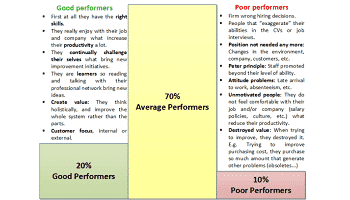[vc_row][vc_column][vc_column_text]
Jack Welch is a leader with followers and detractors. So we are going to analyze the 20-70-10 Rule that some people could say that is a worthy management tool that creates high performance teams, and others say that is a cruel tool because it fosters to fire 10% approximately of the less performer.
The 20-70-10 Rule can be categorized inside the concept of creative destruction (Joseph Schumpeter work). We mean the idea is not firing 10% of the staff to reduce cost rather than change poor performers for other people with the expectation that the new staff could be better. Thus, increasing the number of high performance people and raising the company results.
[/vc_column_text][vc_single_image image=”1238″ img_size=”full” alignment=”center” title=”20-70-10 Rule: Defining good and poor performers”][vc_column_text]
We should ask ourselves a few key questions in order to know if the tool is adding value or not to our organization:
- Can our companies allow itself to maintain poor performers? Nowadays markets globalization, weaker economic drivers, intense competition, product commoditization, etc., make difficult to justified maintaining poor performers.
- What is the internal message maintaining poor performers? The culture of the company would get “paternalistic” or permissive. Then people working close of poor performers would realize that they could reduce their productivity and the firm is not taking any action. So what is it going to happen to the company productivity?
- What is the consequences to maintain a poor performance in the long term? The company would lose competitiveness day a day while other firms are rising their competitive advantage. Thus probably one day the firm would take the decision to close down the facility and move it to other location even outside the country. Thus, the consequence could be fired 100% of the staff rather than 10%. Some people could argue that the battle competing with emerging economies is already lost. Indeed, we have countries like Germany that they are demonstrating that the battle is not lost at all, if firms focus on raising productivity.
- Is it fair to maintain 10% of poor performers having people looking for an employment? Probably it is not. Moreover, it is not fair for the staff that are performing well, because maintaining underperforming people can put in danger the company and their jobs in the future.
- What about good performers? Poor performers are easy to retain, but good performers are a different issue. Good performers are demanded by the market, and they are more confidents in their abilities in order to move to other company. Moreover, good performers expect to work in high performance environment, and be paid according to the value that they create. Although with poor performers into the company is difficult to fulfill those expectations. So there is a real risk that good staff would get out of the firm, and mediocre staff would grow even higher than 10%.
- Why do we maintain under performers? In order to answer properly this question we should ask ourselves another question before: do we maintain under performers because it is an unpleasant task to fire people?
In turnaround projects where poor management is an issue, one of the most important causes of the company decline is because we do not have the right people. It is not unusual to find in those firms 10% of poor performance staff. So in those cases “getting out the bus” that staff allow us to increase firm results, and accelerate the change management process bringing new people with new mindset and abilities to the organization.
We have to highlight that organizations have the responsibility preventing poor performers, and we can suggest to prevent poor performers: First, having good performers in key positions, because good performers do not use to tolerate the poor performance. Second, selection process should be excellent. Third, making a periodic follow up of the team and specially the new staff, because two or three months is enough to realize if new employees should continue or not. It is better to “get out the bus” people in the second or third month that allow continuing in the company.
Finally, while poor performers by definition are people who damage the organization, and “getting out the bus” those people would not be an issue for the company. What it is not clear for me is the following: as Jack Welch suggests continually changing 10% of the staff that worst performs (being categorized like poor performers although they are not necessary underperforming, just they are on the bottom of the list) is getting any return. I mean there is low risk changing the staff that underperforms, despite changing people that are not “really” underperforming is increasing the risk to get the worse staff. Additionally we are losing the investment done in our current staff, and we have to invest in finding and training new workers. Moreover, we are creating an unhealthy stress in the organization. So I would not personally recommend continually changing 10% of the staff just because they are the worst performers.
[/vc_column_text][vc_cta h2=”Looking for a Turnaround or Transformation?” h2_font_container=”font_size:20x|color:%23000000|line_height:24x” h2_use_theme_fonts=”yes” shape=”square” style=”flat” add_button=”right” btn_title=”request a visit” btn_style=”flat” btn_color=”theme_style_2″ btn_align=”right” btn_i_align=”right” btn_i_icon_fontawesome=”fa fa-angle-right” use_custom_fonts_h2=”true” el_class=”third_bg_color” btn_link=”url:http%3A%2F%2Fc2024.strategok.com%2Fcontact%2F||target:%20_blank” css=”.vc_custom_1470428453356{padding-right: 20px !important;padding-left: 20px !important;}” btn_add_icon=”true” btn_button_block=”true”][/vc_cta][/vc_column][/vc_row]
